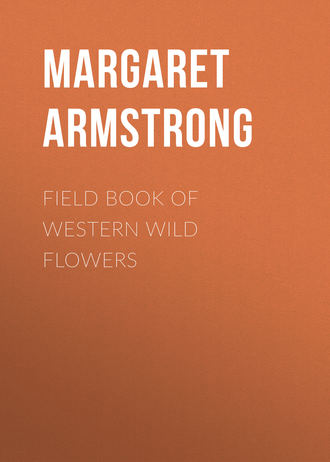 полная версия
полная версияField Book of Western Wild Flowers
There are a great many kinds of Trifolium, or Clover, difficult to distinguish; low herbs; leaves usually with three leaflets, usually toothed; stipules adhering to the leaf-stalks; flowers in heads or spikes; stamens usually in two sets of nine and one; pods small, mostly enclosed in the calyx, usually with one to six seeds.
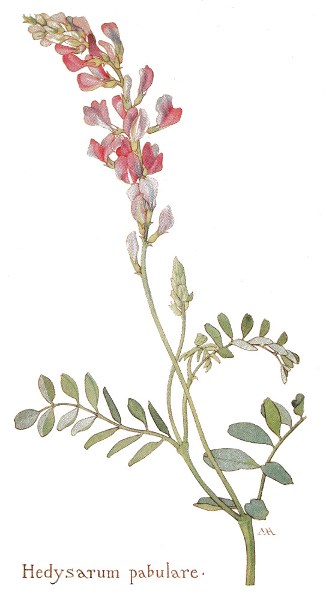
Hedysarum pabulare.
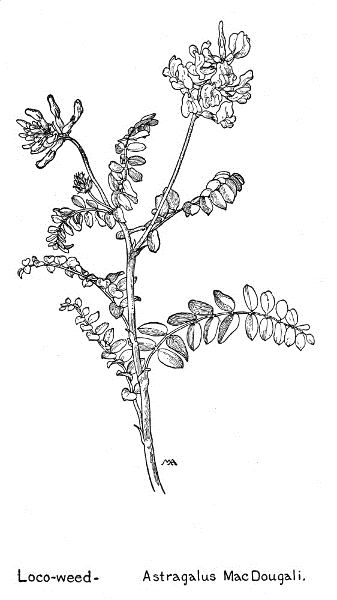
Loco-weed – Astragalus MacDougali.
Clover
Trifòlium tridentàtum
Purple
Spring, summer
Cal., Oreg., Wash.
This is very common from the coast to the Sierra foothills, but there are many named varieties. It is smooth all over and grows from eight inches to two feet high, with spreading stems and narrow leaflets, which are toothless, or have teeth and bristles on the edges. The pinkish-purple flowers form a broad head, over an inch across, with an involucre.
Sour Clover
Trifòlium fucàtum
Cream-color
Spring, summer
Wash., Oreg., Cal.
This has queer-looking flowers and is conspicuous on that account. The branching stems are a foot or more tall, the stipules are large, with papery margins, and the leaves are bright green, with a paler spot near the middle of each of the leaflets, which are toothed, or sometimes only bristly on the edges, and the flowers form a head about an inch and a quarter across, with a broad involucre. The calyx is very small and the corolla is cream-color, becoming much inflated and changing to deep pink as the flower withers. The effect of the cluster is curiously puffy and odd in color. This grows rankly in low alkaline and brackish places.
There are many kinds of Psoralea, widely distributed; ours are perennial herbs, without tendrils, the leaves with three or five leaflets, with glandular dots on them and usually bad-smelling. The flowers are white or purplish, and the pod is short, with only one seed.
Native California Tea
Psoràlea physòdes
White
Spring, summer
Cal., Oreg., Wash.
This is a rather pleasing plant, for the foliage is pretty, though the flowers are too dull in color to be effective. It is almost smooth all over, a foot or more tall, with several spreading stems and rich green leaves, thin in texture and giving out a rather pleasant aromatic smell when crushed. The flowers are less than half an inch long, with a somewhat hairy calyx, covered with dots and becoming inflated in fruit, and a yellowish-white corolla, more or less tinged with purple. This is common in the woods of the Coast Ranges. The foliage was used as tea by the early settlers.
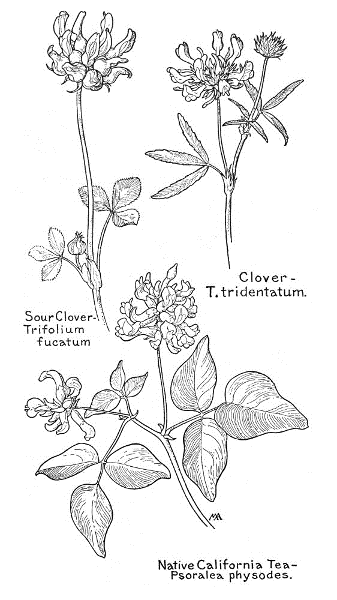
Sour Clover – Trifolium fucatum.
Clover – T. tridentatum.
Native California Tea – Psoralea physodes.
There are many kinds of Cytisus, natives of Europe, Asia, and Africa, named for Cythrus, one of the Cyclades, where the first species was found.
Scotch Broom
Cýtisus scopàrius
Yellow
Spring, summer
West, etc., except Ariz.
A handsome branching shrub, about five feet high, with almost smooth or quite hairy leaves, with three, toothless leaflets, and fine clusters of flowers, each an inch or more long, with a yellow two-lipped calyx and a golden-yellow corolla, deeper in color at the base of the standard and at the tips of the wings; the stamens ten, in one set; the style curved in. The pod is flat, smooth on the sides, but hairy along the edges, one or two inches long and curling when ripe. This is said to have been brought to California by Cornish miners.
SENNA FAMILY. Cassiaceae
A large family, most of them tropical; trees, shrubs, and herbs, with flowers more or less irregular in form, but not like the flowers of the true Pea, though sometimes resembling them; calyx usually with five sepals; corolla with five petals, overlapping in the bud, the petal which corresponds to the standard folded within the two side petals, instead of covering them, as in the Pea flower; stamens, ten, or fewer, in number, usually not united; ovar superior; fruit a pod, mostly splitting into two halves, containing one to many seeds. To this family belong the handsome Red-bud, or Judas Tree, of our woodlands, both East and West; the spiny Honey-locust; the Kentucky Coffee-tree, with its fine foliage, of the central and eastern states; the interesting Palo Verde, with greatly reduced leaves, of the Southwest, and the fine Bird-of-paradise flowers, of the tropics and Mexico, one or two of which are just beginning to grow wild in southern Arizona and California.
There are many kinds of Cassia, abundant in tropical America; herbs, shrubs, or trees; leaflets even in number; flowers usually yellow; calyx-teeth nearly equal; corolla almost regular, with five, nearly equal, spreading petals, with claws; stamens usually ten, sometimes five, often unequal, some of the anthers often imperfect, or lacking; pod flat or cylindrical, often curved, sometimes with partitions between the numerous seeds.
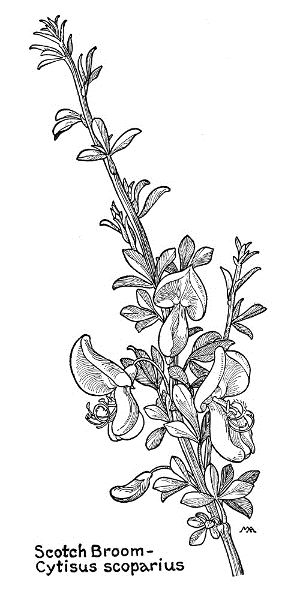
Scotch Broom – Cytisus scoparius.
Desert Senna, Golden Cassia
Cássia armàta
Yellow
Spring
Southwest
The peculiar orange-yellow of these handsome flowers at once attracts our attention, for their tint is quite different from the greenish-yellow, which is so much more common. They grow in the desert, forming big clumps, two feet high and two or three feet across, but have almost no foliage. The numerous, smooth stems are very pale in color, often bluish or gray, with a few dark-green leaves, with six, very small, stiff leaflets, and bearing clusters of numerous, sweet-smelling flowers, almost regular and about three-quarters of an inch across, with a downy calyx and the small, flat pod also downy.
MIMOSA FAMILY. Mimosaceae
A large family, most of them tropical; herbs, shrubs, or trees; leaves alternate, generally compound, usually with two or three leaflets; flowers small, regular and perfect, in clusters; calyx with three to six lobes or teeth; petals of the same number, separate, or more or less united, neither sepals nor petals overlapping in the bud; stamens as many as the petals, or twice as many, or numerous, separate or united; ovary superior; fruit a pod.
There are several kinds of Calliandra, low shrubs or herbs.
Fairy Dusters
Calliándra eriophýlla
Pink
Spring
Arizona
An odd little shrub, pretty and very Japanese in character, about a foot tall, with a few, pale-gray, spreading branches and very scanty foliage. The small leaves are cut into many tiny leaflets and look like those of a Mimosa, the buds are deep pink and the flowers are in clusters towards the ends of the branches and slightly sweet-scented. They are very queer-looking, but exceedingly pretty, for the purplish calyx and corolla are so small that the flower appears to be merely a tuft of many stamens, about an inch long, with threadlike filaments, white at base and shading to bright pink at the tips. The pistil is also long and pink, so the whole effect is a bunch of pink fuzz, airy in form and delicately shaded in color. These little shrubs sometimes bloom when they are only a few inches high, looking very quaint, like dwarf plants in a toy garden, and are among the earliest spring flowers.
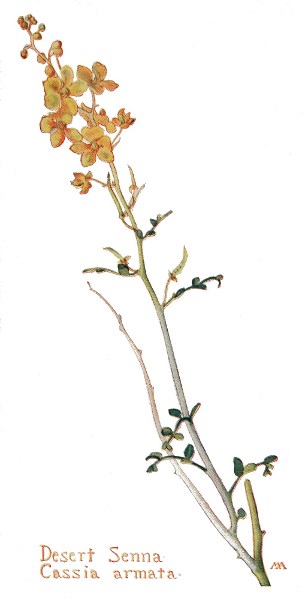
Desert Senna – Cassia armata.
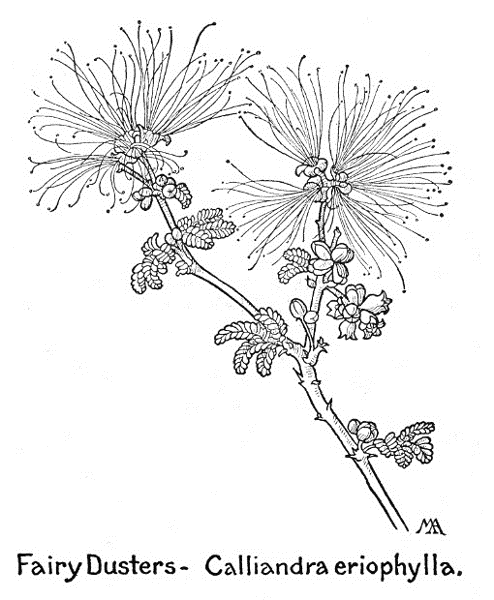
Fairy Dusters – Calliandra eriophylla.
KRAMERIA FAMILY. Krameriaceae
A small family, distributed from the southern United States to Chili; hairy herbs or low shrubs, without stipules; leaves alternate; two bracts on the flower-stalk; flowers purplish, irregular, perfect; sepals four or five, usually large, the outer one commonly wider than the others; petals usually five, smaller than the sepals, the three upper ones with long claws, often united by their claws, sometimes the middle one of the three lacking, the two lower ones reduced to mere fleshy glands and not resembling petals; stamens three or four, united at least at base; ovary superior, with a slender style; fruit spiny, seed one.
Crimson-beak
Kramèria Gràyi
Purplish-pink
Spring
Arizona
A desert shrub, with a pleasant smell like balsam, two to four feet high, with gray, woody stems, abruptly branching, armed with long, brown and gray thorns, and clothed with very small, silvery-gray leaves, downy and thickish. The flowers are curious in shape and color, with five, large, purplish-pink sepals and five, small petals, the two lower ones minute and reduced to glands. The pistil is dark red, the three stamens have green filaments and red anthers, the ovary is downy and prickly, and the downy buds are pale pink.
CALTROP FAMILY. Zygophyllaceae
Not a large family, widely distributed in warm and tropical regions; ours are herbs or shrubs, with opposite or alternate, compound leaves, with stipules and toothless leaflets; flowers complete, usually with five sepals and five petals, and usually twice the number of stamens, with swinging anthers, alternate stamens sometimes longer, filaments often with a small scale near the middle; ovary superior, usually surrounded at the base by a disk; style one, with a five- to ten-lobed stigma; fruit dry.
There are several kinds of Covillea.
Creosote-bush, Hediondilla
Covíllea glutinòsa (Larrea Mexicana)
Yellow
All seasons
Southwest
A graceful, evergreen shrub, common in arid regions and a characteristic feature of the desert landscape, filling the air with its very strong, peculiar odor. It is from three to ten feet high, with many little branches, with blackish knots at the joints, clothed with sticky, dull yellowish-green foliage, the thickish, resinous leaflets very small, in pairs, with almost no leaf-stalk, and uneven at base. The pretty flowers are nearly an inch across, with bright yellow petals, with claws, and silky, greenish-yellow sepals which soon drop off. The filaments are broadened below into wings and have a scale on the inner side. The ovary is covered with pale, silky hairs, so that the older flowers have a silky tuft in the center, and becomes a round, densely hairy fruit, with a short stalk, tipped with the slender style. These little white, silky balls of down are very conspicuous and, as they are mingled with yellow flowers, the bush has an odd and pretty effect of being spotted all over with yellow and white.
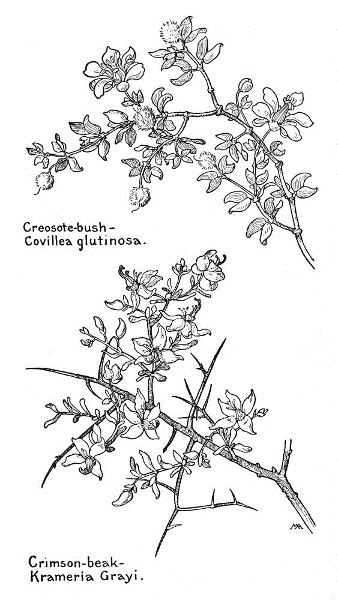
Creosote-bush – Covillea glutinosa.
Crimson-beak – Krameria Grayi.
FLAX FAMILY. Linaceae
A small family, widely distributed in temperate and tropical regions. Ours are smooth herbs, with loosely clustered, complete flowers, having five sepals; five petals, alternating with the sepals; five stamens, alternating with the petals, with swinging anthers and filaments united at the base; ovary superior; fruit a capsule, containing eight or ten, oily seeds.
There are many kinds of Flax, sometimes shrubby at base; with tough fibers in the bark; leaves without stipules, sometimes with glands at base in place of real stipules; flowers mostly blue or yellow. There are numerous, small-flowered, annual kinds, difficult to distinguish and usually somewhat local. L. usitatíssimum, an annual, with deep blue flowers, is the variety which, from time immemorial, has furnished the world with linen from its fiber and oil from its seeds. Linum is the ancient Latin name.
Blue Flax
Lìnum Lewísii
Blue
Spring, summer
West, etc.
An attractive plant, from one to two feet tall, with several, erect stems, springing from a woody, perennial root, with numerous, small, narrow, bluish-green leaves and loose clusters of pretty flowers, each about an inch across. The petals, delicately veined with blue, vary in tint from sky-blue to almost white, with a little yellow at the base. This is common and widely distributed, from Manitoba to Texas and westward, but the fiber is not strong enough to be used commercially.
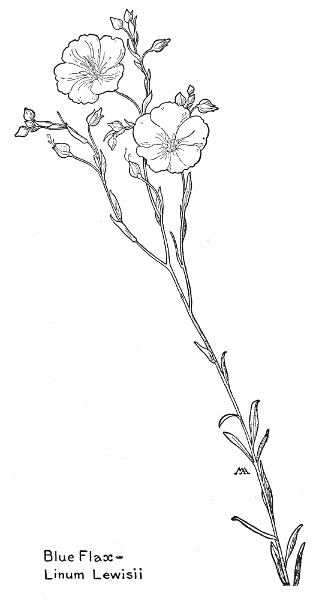
Blue Flax – Linum Lewisii.
WOOD-SORREL FAMILY. Oxalidaceae
Not a large family, mostly tropical. Ours are low herbs, with sour juice, often with rootstocks or scaly bulbs; leaves with three or several leaflets; flowers perfect; sepals five, often unequal; petals five, stamens ten to fifteen; ovary superior, five-celled, the five styles usually separate; fruit a capsule, containing several or many seeds. By some botanists this is merged in the Geranium Family.
There are many kinds of Oxalis. The Greek name means "sour," in allusion to the sour taste of these plants, which contain oxalic acid. The leaves are alternate, at nightfall the leaflets droop and fold together; the stamens are ten, five long and five short, all with anthers, with filaments broadened and united at base.
Yellow Wood-sorrel
Óxalis corniculàta
Yellow
Spring, summer, autumn
Southwest
A pretty little plant, a few inches tall, more or less downy all over, with very slender, reddish, branching stems and light green leaves, about an inch across and thin in texture. The flowers are over half an inch across, with clear yellow petals, often tinged with pale red on the outside, yellow anthers and a green pistil. The capsules are long and downy.
Redwood Sorrel
Óxalis Oregàna
White, pink
Spring
Cal., Oreg., Wash.
One of the most attractive of our woodland plants. The succulent, hairy, reddish flower-stalks, about six inches tall, with two small bracts near the top, spring from a clump of root-leaves. The larger leaves are three inches across, with long leaf-stalks, pale and hairy on the under side, rich green on the upper, each leaflet marked with an irregular blotch of pale green. The younger leaves are lighter green than the older ones and in the bud are neatly folded together, the middle leaflet inside the other two. The leaflets fold back, when it is either too hot or too cold to suit the plant. The delicate flowers are about an inch and a half across, white, pale pink, or rose-color, often veined with deeper color and with a spot of yellow at the base of each petal, and well set off by the foliage, which makes patches of rich and variegated green in dense forest shade.

Yellow Wood-sorrel – Oxalis corniculata.
Redwood Sorrel – O. Oregana.
GERANIUM FAMILY. Geraniaceae
Not a large family, herbs, of temperate regions; leaves lobed or compound, usually with stipules; flowers perfect; sepals and petals usually five and stamens five or ten; ovary superior; fruit a capsule.
There are many kinds of Geranium; stems with swollen joints; stipules papery; five glands on the receptacle, alternating with the petals; stamens ten, five long and five short, filaments united at base; ovary with a beak formed by the five-cleft style, and becoming a capsule, which splits open elastically, the style-divisions becoming tails on the seeds. The Greek name means "crane," in allusion to the long beak of the capsule, and these plants are often called Crane's-bill. Cultivated Geraniums are Pelargoniums, from South Africa.
Wild Geranium
Gerànium incìsum
Pink
Spring, summer
West
In the Sierra woods, and along Yosemite roadsides, in summer we see the purplish-pink blossoms and nodding buds of this attractive plant, resembling the Wild Geranium of the East, growing from thick, perennial roots, with hairy, branching stems, from one to two feet high. The hairy leaves, with three or five, toothed lobes, are fragrant like cultivated geraniums; the flowers, over an inch across, are hairy inside, the petals veined with magenta. They are occasionally white and the plants vary in size and hairiness. G. furcàtum, of the Grand Canyon, has magenta petals, which turn back more.
Wild Geranium
Gerànium Fremóntii
Pink
Spring, summer
Southwest, and Utah, Ida., Col., New Mex.
This has similar flowers, but is a finer plant, forming large, thrifty-looking clumps, one or two feet across, of slightly thickish leaves, dark green on the upper side and paler, with prominent veins, on the under, the root-leaves with about seven, main divisions, the stem-leaves three- to five-cleft, each clump of leaves with several tall, slightly downy flower-stalks springing from it. The calyxes and buds are downy and the flowers bright pink or rose-purple, delicately veined. This grows in somewhat moist ground, at the edges of fields and woody roadsides and on mountain slopes, and is perhaps the handsomest of its clan.
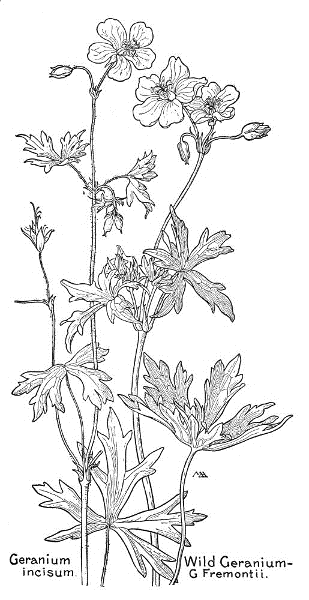
Geranium incisum.
Wild Geranium – Fremontii.
Long-stalked Crane's-bill
Gerànium columbìnum
Purple
Spring, summer
California, etc.
A slender plant, about a foot tall, with pinkish, hairy stems and pretty leaves, thin in texture, with a dull surface; the seed-vessels erect, with bristly beaks. The flowers grow in pairs and are less than half an inch across, with hairy calyxes and notched, purple or magenta petals. This is naturalized from Europe, and common in the East and grows along roadsides, at the edges of fields and woods.
There are many kinds of Erodium, three native in the Southwest and several more introduced, weeds in the Old World and important forage plants in the West; leaves often unequal, with one stipule on one side and two on the other. They resemble Geranium, flower and fruit being nearly the same, but only five of the stamens have anthers, the alternate ones being scale-like, without anthers; styles hairy inside. The Greek name means "heron," in allusion to the long beak of the capsule.
Red-stem Filaree
Eròdium cicutàrium
Pink
All seasons
West, etc.
Though not native, this is the commonest kind, in the interior and semi-arid regions, and most valued for forage. When young it forms rosettes close to the ground, but grows taller and more straggling. The stems are often reddish; the leaves somewhat hairy; the flowers small, in clusters of four to eight, with four bracts at the base; the petals purplish-pink, with darker veins, and hairy at the base, the two upper petals slightly smaller; the sepals tipped with one or two bristles. The ovary is beaked by the united styles, the beak, when the seeds ripen, separating into five, long tails, which twist spirally when dry and untwist when moistened. This is common west of the Rockies, blooming more or less all the year round, varying in size in different soils. Filaree is a corruption of the Spanish Alfilerilla, from "alfiler," a "pin." Other names are Pinkets, Pinclover, Storksbill, and Clocks, so-called by children because they amuse themselves by watching the tails twist about like the hands of a clock. White-stem Filaree, E. moschàtum, common in rich soil, has larger, coarser leaves and a faint scent.

Long-stalked Crane's-bill – Geranium columbinum.
Red-stem Filaree – Erodium cicutarium.
MILKWORT FAMILY. Polygalaceae
Not a very large family, widely distributed; ours are herbs, sometimes shrubby, with no stipules; flowers perfect, irregular, resembling those of the Pea Family, but not like them in structure; sepals five, the two at the sides large and colored, like "wings," the upper sepal forming a "keel"; petals three, more or less united into a tube; stamens usually eight and united; ovary superior, two-celled, with a broad, curved stigma.
There are many kinds of Polygala.
California Milkwort
Polýgala Califórnica
Pink
Spring, summer
Cal., Oreg.
A rather attractive little plant, three to eight inches tall, with smooth leaves and many slender, smooth, woody, stems, springing from slender rootstocks. The purplish-pink flowers become deeper in color as they fade and are quaint in form, over half an inch long, with pink "wings" and yellowish "keel," the petals downy inside and the middle one curving over to form a hood, in which the stamens and style are concealed. This plant has the odd habit of bearing another sort of flower near the root, maturing most of the seed, but without petals, and grows on dry, shady hillsides in the Coast Ranges.
MEADOW FOAM FAMILY. Limnanthaceae
A very small family, all North American, included in the Geranium Family by some botanists; smooth herbs, of wet places, with bitter juice; leaves alternate, lobed and cut, without stipules; flowers perfect; sepals and petals two to five; stamens twice as many as the petals; ovary superior, the five lobes becoming five nutlets; style one.
There are several kinds of Floerkea; sepals and petals three to five; five, small glands on the receptacle, alternating with the sepals; style two- to five-cleft.
Meadow Foam
Floérkea Douglásii (Limnanthes)
White, yellow
Spring
Cal., Oreg.
A charming plant, often covering the meadows with drifts of creamy bloom. The stems are smooth, succulent, brittle and branching, from six to twelve inches tall; the delicate flowers over an inch across, the petals hairy at base, sometimes pinkish, but usually white and yellow.
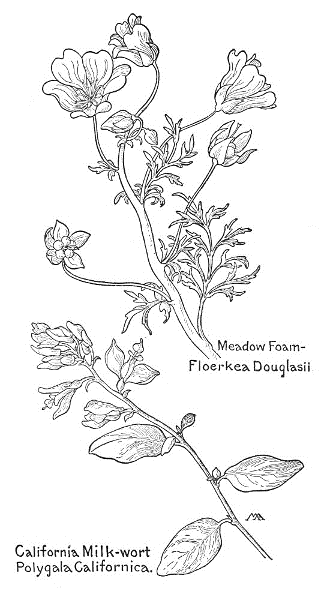
Meadow Foam – Floerkea Douglasii.
California Milk-wort – Polygala Californica.
BUCKEYE FAMILY. Hippocastanaceae
A small family, widely distributed; trees or shrubs, with opposite, compound leaves, no stipules and terminal clusters of irregular flowers, some perfect and some with only pistils or only stamens; the calyx tubular or bell-shaped, with five, unequal lobes or teeth; the petals four or five, unequal, with claws; the stamens five to eight, with long filaments; the ovary superior, with no stalk, three-celled, with a slender style; the capsule leathery, roundish or slightly three-lobed, smooth or spiny, with one to three, large, polished seeds.
There are a good many kinds of Aesculus, or Horse Chestnut, natives of America and Asia; the leaves palmately compound, with toothed leaflets; the flowers of two sorts, the fertile ones few in number, near the top of the cluster, with long, thick styles, and the sterile flowers with short styles.

